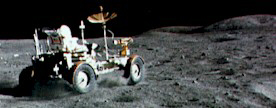
Dr. Robert Ballard is better know for discovering the watery
graves of the Titanic and Bismarck, but I think his most important discovery happened in
1977. Near  the
Galapagos Islands off the coast of Ecuador, Ballard and his crew discovered giant worms,
some more than two and a half meters (eight feet) long, living inside white tubes and
clustered around underwater hot springs.
the
Galapagos Islands off the coast of Ecuador, Ballard and his crew discovered giant worms,
some more than two and a half meters (eight feet) long, living inside white tubes and
clustered around underwater hot springs.
These large, odd-looking animals were surviving on the
sunless, otherwise barren sea floor by what turned out to be an entirely unknown process
of life.
 Bacteria convert
chemicals (from the sulfur-rich fluid spewed out of vents) to energy, in a process called
chemosynthesis. Other animals eat bacteria, harbor bacteria in their bodies, or eat
bacteria- eaters. Vent worms have no mouth or digestive tract. Instead, chemosynthetic
bacteria living in their tissues provide nourishment. Hemoglobin (which transports
hydrogen sulfide to the bacteria) makes the vent worms red.
Bacteria convert
chemicals (from the sulfur-rich fluid spewed out of vents) to energy, in a process called
chemosynthesis. Other animals eat bacteria, harbor bacteria in their bodies, or eat
bacteria- eaters. Vent worms have no mouth or digestive tract. Instead, chemosynthetic
bacteria living in their tissues provide nourishment. Hemoglobin (which transports
hydrogen sulfide to the bacteria) makes the vent worms red.
In the light of Ballard's giant worms, the chances of finding
life on another planet, specifically Europa, has risen drastically. Io, a Jovian moon, has
been found to have active volcano's. The same process with drives this volcanic activity
should also be found on Europa. NASA's space probe 'Galileo' has shown evidence of liquid
water, or at least 'warm ice'. If life exists in the solar system, not of Earth origin,
then Dr. Robert Ballard has made us take a long hard look a Europa.
 John Young Everybody
should have an out and out hero, this is mine. I remember sitting at home with the family
on a Sunday evening, watching Young and Crippen fly NASA's first untested manned flight,
STS-1. Fingers' crossed as Columbia flew. I worried for them as we learnt of the missing
heat resistant tiles, and crossed my fingers again for the landing. Later, I saw a very
'chuffed' John Young walking around the parked shuttle.
John Young Everybody
should have an out and out hero, this is mine. I remember sitting at home with the family
on a Sunday evening, watching Young and Crippen fly NASA's first untested manned flight,
STS-1. Fingers' crossed as Columbia flew. I worried for them as we learnt of the missing
heat resistant tiles, and crossed my fingers again for the landing. Later, I saw a very
'chuffed' John Young walking around the parked shuttle.
 One of my earliest memories, is that of watching a man walk on the moon. I
hope I wasn't dreaming this, and I'd like to think I was watching John Young, and Apollo
16.
One of my earliest memories, is that of watching a man walk on the moon. I
hope I wasn't dreaming this, and I'd like to think I was watching John Young, and Apollo
16.
First to fly Gemini, first to fly the Space Shuttle, first
man to fly into space 6 times, first to use a computer in space, 9th man on the moon, and
still on the active flight roster at NASA.
 Professor Carl Sagan built a spaceship out of his
imagination, with enough room for 'Billions and Billions' of people. I, like the many
millions of fans, found a seat on this craft, called Cosmos, and flew with him throughout
the solar system and beyond. He challenged the mind, and infected his passenger with an
enjoyment of exploring the stars.
Professor Carl Sagan built a spaceship out of his
imagination, with enough room for 'Billions and Billions' of people. I, like the many
millions of fans, found a seat on this craft, called Cosmos, and flew with him throughout
the solar system and beyond. He challenged the mind, and infected his passenger with an
enjoyment of exploring the stars.
Sagan is one of these larger than life
characters, and it's hard to believe that one man did all this. His work in unmanned
spaceflights - Mariner 9, Viking, Pioneer, Voyager and Galileo, his many books, SETI,
pioneer of Exobiology, showing Venus to be a hell like planet, discovering that Titan has
an atmosphere containing organic molecules similar to the building blocks of life, are
only a sample of the highlights of his career.
In 1976, after Viking I and II had landed on
Mars, Carl Sagan pointed out that they had landed on the most boring spot on Mars, and
that the next mission to Mars should be a 'rover', able to go exploring. 11 years later
NASA announced that the Pathfinder base, newly arrived on Mars, and carrying a little
rover, was to be renamed in memory of the late astronomer.

The view from 'The Carl Sagan Memorial Station'